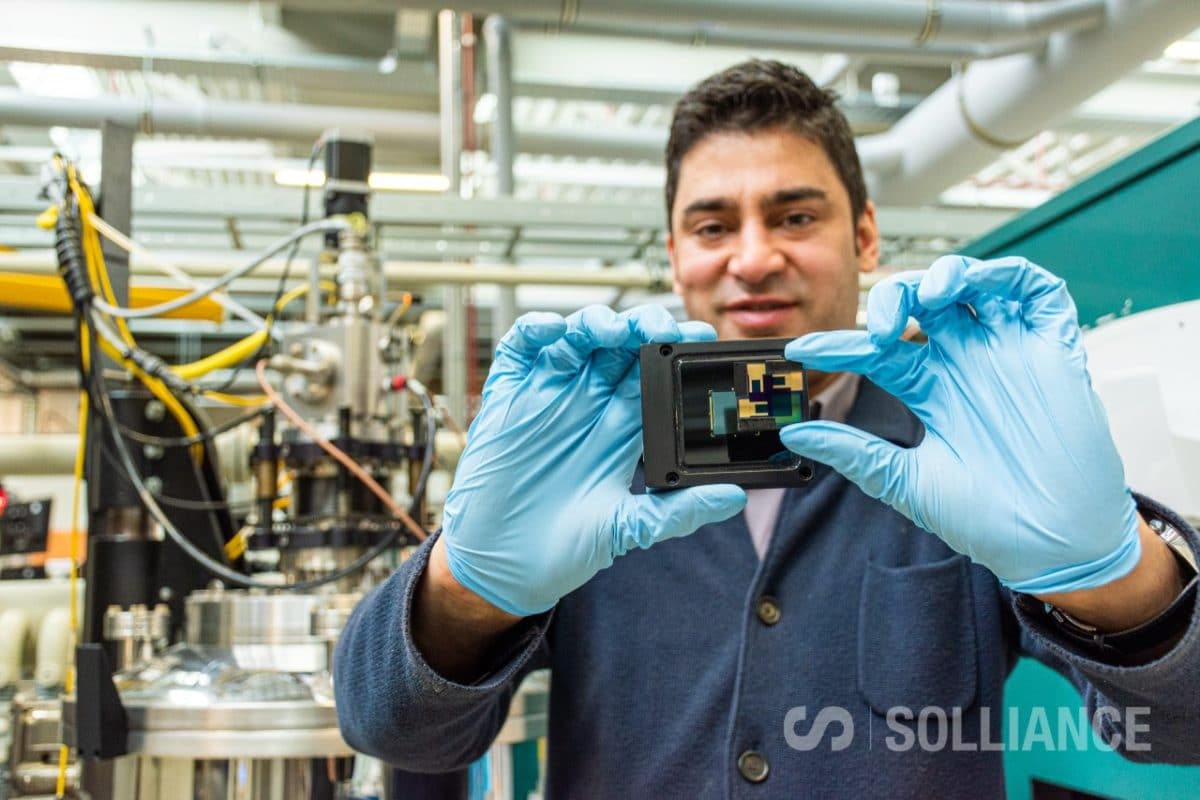From pv magazine Global
European Solliance Solar Research (Solliance), a consortium based in the Netherlands, has achieved a 28.7% power conversion efficiency on a transparent perovskite solar cell combined with a crystalline silicon solar cell in a four-terminal tandem configuration.
The device is based on an 18.6% efficient highly near-infrared transparent perovskite cell built by Dutch research institute TNO, EnergyVille, a joint venture between the Flemish research partners KU Leuven, VITO, UHasselt, and Imec, and the Eindhoven University of Technology, which are all members of Solliance, and a prototype of a c-Si interdigitated back contact (IBC) silicon heteroJunction (SHJ) cell developed by Japanese electronics manufacturer Panasonic.
Improvements on the perovskite solar cell, which measures 9 mm2, were the decisive factor to increase the overall efficiency of the tandem cell by around 1.5%, the researchers stated, adding that they tuned the optoelectrical properties of the perovskite solar cell to better match the optical properties of the other cell. “Next, we determined the loss factors in the four-terminal configuration and minimised these step by step,” said TNO researcher Dong Zhang. “Finally, we optimised the light management of the complete tandem device, in other words, we maximised light absorption in the tandem solar cell.”
The perovskite cell was also combined with other kinds of solar cells and remarkable efficiencies were also achieved. In combination with a commercial c–Si metal wrap through (MWT) SHJ cell co-developed by TNO and Japanese solar manufacturer Chosu Industry, the efficiency reached 28.2%. In another combination with a c-Si PERC cell provided by Solarlab Aiko Europe GmbH, the German subsidiary of Chinese module maker Aiko, the efficiency was 27.7%.
Furthermore, the research team combined the transparent perovskite cell with a flexible copper indium gallium selenide (CIGS) tandem solar cell built by MiaSolé Hi-Tech, a U.S. unit of Chinese thin-film specialist Hanergy, and the efficiency was 27.0%.
“These excellent results form the basis for the next phase in the development, which includes upscaling of the area and the processes,” said researcher Mehrdad Najafi. “Currently, low–cost upscaling processes for large area modules and maintaining the same performance are being developed by the Solliance partners TNO and imec/EnergyVille.”
The scientists also specified that the four-terminal perovskite/c–Si tandem cell could be applied in bifacial c–Si solar modules, as it is able to deliver a total power generation density of 320 W/m², depending on the albedo.
Solliance announced a 26.5% power conversion efficiency for a solar cell combining two different thin-film PV technologies in a tandem configuration in February. In November 2019, MiaSolé announced a new record of 18.64% for a flexible CIGS cell. The landmark achievement represented a significant improvement on the previous record of 17.44%, set five months earlier. In January 2019, the consortium achieved a 21.5% efficiency for a flexible copper indium gallium selenide (CIGS) tandem solar cell based on perovskite.
Solliance and the TNO had also said in March 2018 that they had recorded a 26.3% efficiency rate on a transparent perovskite solar cell combined with a crystalline silicon solar cell. A month later, Solliance also announced a new record performance for large-area perovskite modules, with a 14.5% conversion efficiency level.
This content is protected by copyright and may not be reused. If you want to cooperate with us and would like to reuse some of our content, please contact: editors@pv-magazine.com.









By submitting this form you agree to pv magazine using your data for the purposes of publishing your comment.
Your personal data will only be disclosed or otherwise transmitted to third parties for the purposes of spam filtering or if this is necessary for technical maintenance of the website. Any other transfer to third parties will not take place unless this is justified on the basis of applicable data protection regulations or if pv magazine is legally obliged to do so.
You may revoke this consent at any time with effect for the future, in which case your personal data will be deleted immediately. Otherwise, your data will be deleted if pv magazine has processed your request or the purpose of data storage is fulfilled.
Further information on data privacy can be found in our Data Protection Policy.